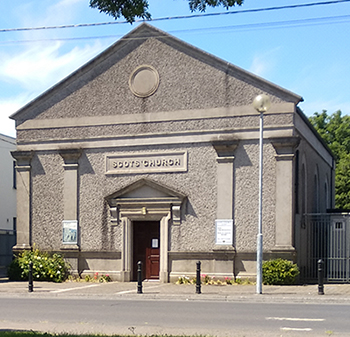Scots’ Church
Published in Gems of Architecture, Issue 2 (March/April 2021), Volume 29Athy Road, Carlow, Co. Carlow
By Simonas Vilcauskis

Above: The Scots’ Church on Athy Road, Carlow, designed by the English-born architect Thomas Alfred Cobden. (Simonas Vilcauskis)
The history of Presbyterianism in Carlow can be traced back to 1655, when Roger Muckle was recorded as an ‘Independent minister under the Commonwealth’. A congregation established under the Synod of Munster flourished for a time but was extinct by 1750. A revival was brought about by the Hampshire-born merchant Thomas Cox (d. 1849), who, finding little satisfaction in the services given by the Established Church, applied to several societies to have the need for gospel-preaching in the town remedied. One application stirred the interest of the Trustees of the General Fund of the Presbyterian Church of Ireland, who in 1817 directed the minister serving Stratford-on-Slaney to preach as frequently as he could in Carlow and to report back on the prospect of re-establishing a congregation there. The signs were encouraging and the renewed congregation was placed under the care of the Synod of Ulster, with the local Methodist meeting-house providing a temporary setting for services.
The Carlow Morning Post reported that the foundation stone of a new church was laid on 18 June 1818 ‘by the Sovereign of the Town of Carlow’. The site on Athy Road was leased from Nathaniel Proctor and the church, estimated to cost £800, was designed by the English-born architect Thomas Alfred Cobden (1794–1842), one of the co-signatories of Cox’s application to the Presbyterians.
The circumstances behind Cobden’s move to Ireland are unknown, but commissions from a range of clients, ecclesiastical and secular, private and public, sustained a career lasting almost twenty years before he returned to London in 1832. The majority of his work was based in County Carlow, with the occasional foray into neighbouring counties, and he proved equally adept and inventive whether working in the Classical or the Gothic style.
An architectural ecumenist, Cobden designed Carlow’s Church of Ireland church (1829–33) and Catholic cathedral (1829–34). Both are in the Gothic style, make extensive use of locally sourced silver-grey granite and are announced by spectacular spires with an eye-catching array of pinnacles. However, the Scots’ Church, his earliest, takes the form of a miniature temple, its roughcast street front showing a series of stucco pilasters supporting a rudimentary pediment. A moulded Classical door-case serves as the focal point of the façade. Elegantly arcaded openings on the long sides feature conventional Georgian sash-windows given the slightest ‘ecclesiastical’ flavour by sinuous ogee glazing bars.
The Carlow Morning Post suggests that work on the church was completed within four months, the cost having overrun by £120 15s. 3d. owing to the inclusion of a gallery, but it was not officially opened for worship until September 1819. The focus of the hall-like interior was, and remains, the elevated pulpit set within a segmental-arched shallow alcove. The church was altered in 1900 when Revd Joseph Dempster (1855–1914) oversaw the replacement of the roof; probably the ceiling, timber boarded in a geometric framework of Canadian pine beams, was installed then. The gates and railings were removed at a later date, opening the church directly onto Athy Road, but the Scots’ Church otherwise survives intact as the earliest surviving place of worship still in active use in Carlow.
Simonas Vilcauskis is a student in the Department of Architecture, Waterford Institute of Technology. Series based on the NIAH’s ‘building of the month’, www.buildingsofireland.com.
















